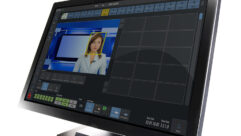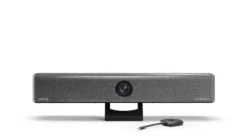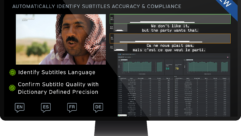
Technology Showcase: Wireless-microphone Control Systems
Jul 1, 2007 12:00 PM,
By Bennett Liles
Networking simplifies multiple-mic control and monitoring.

Mipro Electronics PC-11
With the arrival of setups with multiple wireless microphones came the problem of controlling and monitoring them as one group. For many years, the solution was simply to stack or rack the receivers to provide a more integrated hardware unit. (This has been most evident in the emergence of antenna signal distributors that allow all receivers to use a common antenna set.) Then came rack units with modular receivers. In these, the base unit can accommodate a number of slide-in receiver modules, but in most cases, unified control of all modules at once has been limited to powering them up or down with a single switch.

AKG Hub 4000 Q Concentrator
NETWORKING ARRIVES
More recently, the advantages of network communication have come to the fore, along with the unique ability of specialized software applications to instantly gather and organize information and allow distribution of control commands to dozens of units at once over the network.
Networking capability has already been built into data projectors and room AV device control/monitoring, power amplifiers, and digital audio distribution. So it’s only natural that the trend has found its way into the world of controlling and monitoring wireless-microphone systems. We will examine the applications presently offered by nearly a dozen companies and have a look at the various features they offer. These products are not part of the physical wireless receiver itself, but they interface to it via some form of networking and present a unified control/monitoring interface on a PC screen. The software is normally offered as a free download along with updates from the manufacturer’s website and/or provided on CD with the purchase of the wireless-mic system. There is also one interesting hardware entry that takes the form of a familiar infrared TV remote for wireless-microphone configuration. Other hardware items examined are marketed as part of the control networking infrastructure.
AKG offers its Hub 4000 Q and System Architect control software from Harman Pro for control and monitoring of multiple SR-4000 receivers in groups of eight over the HiQnet network. Operating in similar fashion to any computer network hub, the Hub 4000 Q incorporates LEDs on the front panel to indicate connection status with each receiver attached to its rear-mounted RJ-11 network ports.
When the System Architect software is started, it searches the network and automatically identifies each Hub 4000 Q connected to the computer’s network interface card. The main window displays the SR general panel and eight channel strips. If fewer than eight devices are connected, the remaining channel strips are grayed out. As each receiver is turned off, its channel strip turns dark. The SR general panel allows activation of environment scan and RF monitor functions. Below it are buttons for simultaneous control of clear warnings, mute, and on/off for all active channel strips. When a channel strip is clicked, it becomes surrounded by a yellow frame. Each channel strip shows the hub and module number; a customized source ID; mic gain, RF, and AF levels; battery status; RF low; and clip lights, along with receiver-clear warnings, mute, and channel on/off buttons. A properties box may be called up to allow changes in all channel parameters. Environment scan uses one receiver to scan the selected RF band and display a graphed RF spectrum analysis. The System Architect offers a host of additional features that present the user with a comprehensive wireless system control interface.

Audio-Technica Artist Elite wireless control interface
For its Artist Elite 5000 series, Audio-Technica markets its Windows-based Artist Elite wireless control interface application for PCs. The Artist Elite receiver connects to the computer through a hub or router, or directly via a Cat-5 crossover cable with RJ-45s on each end. Receivers may also be daisy-chained with a link cable where the unit at the head of the line connects directly to the PC.
The channel-detail window presents a display showing each receiver’s parameters, including a color-coded RF-level ladder, the assigned receiver name and frequency, the squelch-level setting, an entry box for name changes, and a lock selector to prevent tampering. Also shown is the color-coded AF-level ladder with meter hold button, antenna power button, IP and link addresses, and receiver-mute and display-close buttons. Status indicators include transmitter name and type, transmitter input select, gain trim setting, and transmitter power and lock settings. Transmitter mute level and low battery warnings complete the channel-detail display. There is also a 10-view mode that allows users to view essential parameters of 10 receivers simultaneously.
Receiver frequencies may be set manually by stepping up or down through them or by selecting IntelliScan from the tools menu and allowing it to automatically set each unit’s frequency within the same frequency group. The receiver lock function can be set to allow changes from the receiver only, from the computer only, from both, or from neither.

Beyerdynamic Opus 800
Along with its Opus 800 wireless-microphone system, Beyerdynamic offers the Opus 800 receiver-control system, developed by Mipro Electronics. Control software for the company’s latest Opus 900 series is still in development, and it will be almost identical to the Opus 800 application. The receivers are connected along a network that is interfaced with the computer serial port via an RS-485 bus connector. A Windows-style dropdown menu allows users to save or recall receiver group configuration files on the computer. The receiver dropdown menu provides access to an automatic-detection feature to find receivers on the network. The reconnect function restores the link in the case of a network interruption. To save screen real estate, the Hide Unused Panel feature shows only those individual displays associated with active receivers. The full-view option toggles the view of all receivers to one- or two-page mode. In addition, there is COM port selection, baud-rate setup, and a help file.
Each receiver display includes an RF-level meter from both A and B antennas and an audio-level meter. The top band provides an area for receiver name ID and low-transmitter-battery and low-RF-level warning lights. At the bottom of each individual receiver display is a receiver-mute button and a selector button for a more detailed receiver view. In the non-detailed mode, this panel can display up to 64 receivers on one screen. The RF monitor shows a graph line display of the RF levels from A and B antennas along with a horizontal pink line showing the RF squelch level.

Electro-Voice Rev-Link
The Electro-Voice Rev-series wireless-microphone systems may be networked on the CAN bus, a balanced serial interface for command-and-data transmission, through a UCC-1 USB-to-serial interface or the NetMax N8000 for control and monitoring with the Rev-Link software application. Rev-Link allows control and monitoring of all the receiver’s front-panel functions along with low-RF and low-transmitter-battery alarms. The screen provides a multiple-receiver display including group, channel, and frequency assignments; battery level; and RF information. ClearScan may be run to scan the spectrum and select channels clear of interference, and with the new analyzer mode, the scan results can be displayed like the graph on a spectrum analyzer. For shows with a number of different acts in rapid succession, scenes can be stored in rehearsal and recalled, along with the clear frequency settings, to allow touring acts to have preset frequency assignments for any location. Control functions include selective muting of each channel at the receiver output. Rev-Link is compatible with Iris-Net audio networking software, so the Rev-series wireless-microphone system may be used on the same network as the EV remote-controlled amplifiers. Rev-Link is supplied on a CD with the purchase of any Rev-series receiver, and updates are available on the Electro-Voice website.

Lectrosonics VRpanel
The LecNet2 control software from Lectrosonics is included with the Venue receiver, a rackmounted system with slide-in receiver modules and a built-in antenna multicoupler. All receiver settings and functions can be controlled through USB and serial ports using LecNet2. The VRpanel main screen can display up to 16 receiver modules — including channel name, number, group, and the frequency assigned — and the screen resizes as modules are added. Users can double-click on any module’s display to open the Set-Up VR dialog box, which they can use to tune the receiver, select diversity and compatibility modes, and set the audio phase and output level. Users can right-click on the individual receiver display to open special functions including the RF spectrum scanner and walk test recorder, which allows the RF level to be recorded on a strip chart along with the audio. As the location is announced into the microphone, the receiver display shows the RF level in that area to reveal problem areas for dropouts.
The VRpanel spectrum scanner provides a graphical reading on clear RF areas in the spectrum and displays block, channel, frequency, and TV channel. Following Windows convention, the file menu includes commands for loading and saving configurations, upgrading firmware, and exiting the application. The configuration menu allows users to build configurations by detecting and adding VR systems, and the help menu provides access to online help, VRpanel demonstration mode, and an about page that displays the software version number.
Mipro Electronics offers an interesting hardware entry in its PC-11 remote control. This handheld, battery-powered device resembles a TV or stereo receiver remote control, but it communicates by infrared link to Mipro ACT-series wireless microphones. The unit has an LCD screen, a power button, an arrow pad, and a numeric keypad along with enter and clear buttons. The ACT-series transmitters feature an infrared port that picks up changes in frequency assignment from the PC-11. The user simply powers up the unit, navigates to “old” mode, and enters six digits from the keypad with no decimal points. The user then aims the unit’s top-mounted IR port at the transmitter and presses the “ENT” (enter) button. The new frequency is instantly loaded into the transmitter. Of course, the link is strictly line-of-sight, but the simple procedure can save valuable time.

Sabine SWM 7000
Sabine SWM 7000 remote control software provides single-PC control of multiple SW71-NDR and SW72-NDR receivers. The receivers are equipped with RJ-45 ports for RS-485 daisy-chain connection of as many as 35 2-channel receivers, providing control of up to 70 wireless-microphone channels. The first receiver connects to the PC on either a USB or a 9-pin RS-232 port. Any control or indicator on the receiver is also available in the software, which also offers additional capabilities. These include parametric and anti-feedback (FBX) filter control with sensitivity and persistence adjustments on FBX filters. Adjustable high- and low-cut filters, compressor controls, and memory options for storing channel configuration settings are also available. RF Scan and Report sweeps all channels, measures RF strength, and delivers a hierarchical report of the results based on the signal strength. The user can give each channel a customized name and mute the output of the receiver. The PC display shows mute status along with battery strength and low-battery warning, pad and low-cut filter settings, and RF signal strength. For handheld transmitters, the software also displays the type of capsule being used. The combined effect of all filters on the channel’s audio frequency response is shown as a graph. A variety of security options allows users to save setup parameters, make temporary updates, and then recall the saved settings. Parameters set for one channel may also be copied to others.

Sennheiser Net-1
The Net 1 network system from Sennheiser enables control of as many as 50 wireless-microphone channels from a PC using the Wireless Systems Manager software application. Up to 10 Sennheiser Evolution wireless G2 or 3000/5000 Series receivers connect to each rackmounted Net 1, and as many as five Net 1 devices can be linked by Ethernet to the controlling PC. The software enables any parameter adjustment that can be made on the receiver to be adjusted from the PC as well. A frequency manager section allows the user to auto-scan the RF environment using a selected receiver and transmit that information into the Net 1. Then the frequency assignment and other information can be transferred by infrared link to the selected receiver’s corresponding microphone or body-pack transmitter. The scan-results window displays the frequency bank selected, and when the scan is done, the user can click the “next” button to allocate the frequencies. The frequency manager section provides a simple way to drag and drop available frequencies from a list onto the selected receiver or use automatic allocation. The master scene view shows each receiver and displays the RF level on each antenna, the port number, the assigned channel name and frequency, the battery level, and the audio output level with highest peak marker. Peak levels will turn the AF level section to a red hue to notify the operator to attenuate the level. The properties list shows the values being displayed and the upper and lower frequency limits for the channel.

Shure Wireless Workbench
The Wireless Workbench application from Shure allows centralized PC control of multiple Shure wireless-microphone systems through the UA888 interface accessory. Using the ShureLink cable supplied with each unit, the wireless systems can be monitored and controlled as a network in groups of 16. From the PC, an operator can monitor the RF level, audio level, A/B antenna diversity, and transmitter battery level. Operators can easily control the group/channel assignment, frequency, squelch, and lock/unlock status with mouse clicks, and they can enter the customized name for each input from the PC keyboard. The RF plotter function can identify problems in the immediate RF area by noting RF levels and graphically presenting these during transmitter walkarounds. The results can be printed and saved as a file with software version 2.11 and higher. This is also possible with the results of the frequency scanner in determining possible sources of interference in the available spectrum. Multiple receiver settings can be stored as scenes and instantly recalled. For security, password protection is also available. New in version 4.2 is the capability to control the system from two or more computers simultaneously. Also new is the ability for the RF scan feature to display scan results for three separate bands on one screen, as well as storage of a complete set of backup frequencies for immediate recall. Remote Band Scan enables the user to perform single-band channel scans through AMX and Crestron systems. The RF channel properties window allows users to set the squelch level, assign the frequency, and set the audio output level, as well as clicking mute and front-panel lockout check boxes to activate these functions. Also in this window are transmitter gain and power and sensitivity selections. Remaining transmitter battery time visually counts down for timing battery replacements.

Sony MB-8N network controller
For network control of the MB-8N wireless-microphone systems, Sony supplies the MB-8N Network Controller software with the MB-8N tuner base unit. This rackmount device accepts up to four WRU-8N synthesized tuner units. Cat-5 network cable connects the MB-8Ns to the computer through a hub, and each MB-8N is provided its own consecutive IP address. The software searches out and displays all connected MB-8Ns. Beneath a Windows-style menu bar, a tree display shows the connected resources in collapsible segments. The main screen shows monitor cells, each of which corresponds to a receiver module. The screen also shows the programmed channel name, audio level, RF level, and diversity reception information, in addition to page-selection buttons, the start/stop button, and an event log. Along with the usual parameter displays and warnings, a very useful fan motor fault icon indicates problems with the MB-8N’s fan. Detailed settings include the audio level settings, antenna attenuation level, receiver headphone level, and antenna power check box for active remote antenna power. Users may make assignments individually to the receivers or configure all four assigned to any MB-8N at once. They may copy the parameters of any monitor cell to another by simply dragging the first over the second on the display.
For More Information
AKG Acoustics
www.akgusa.com
Audio-Technica
www.audio-technica.com
Beyerdynamic
www.beyerdynamic.com
Electro-Voice
www.electrovoice.com
Lectrosonics
www.lectrosonics.com
Mipro Electronics
www.mipro.com.tw
Sabine
www.sabine.com
Sennheiser
www.sennheiserusa.com
Shure
www.shure.com
Bennett Lilesis a freelance television production engineer and AV technician in the Atlanta area. He specializes in government video production, distance learning, and videoconferencing.










